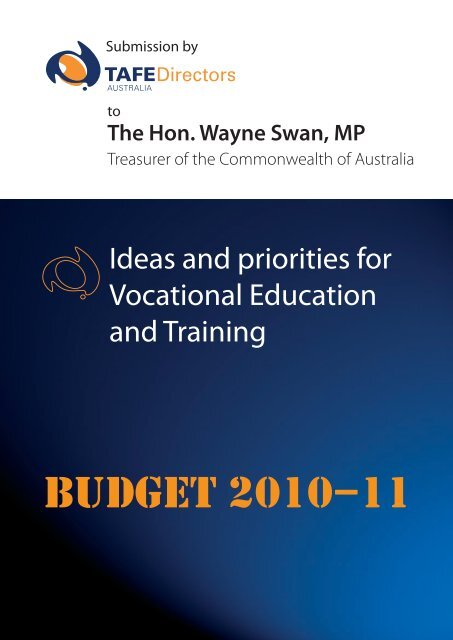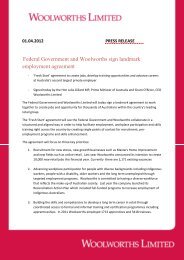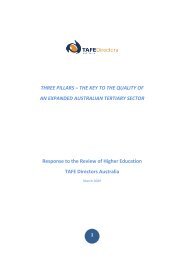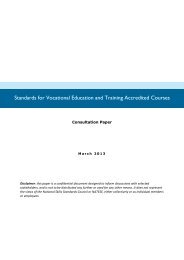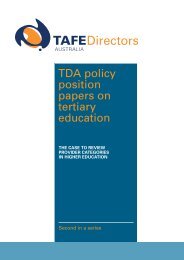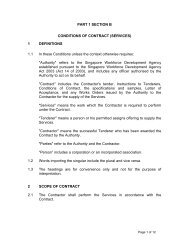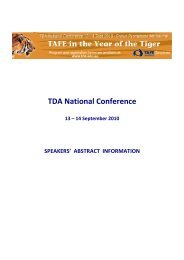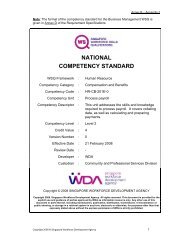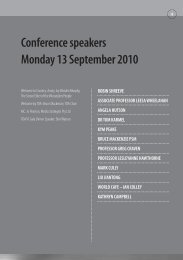here - TAFE Directors Australia
here - TAFE Directors Australia
here - TAFE Directors Australia
Create successful ePaper yourself
Turn your PDF publications into a flip-book with our unique Google optimized e-Paper software.
Submission by<br />
to<br />
The Hon. Wayne Swan, MP<br />
Treasurer of the Commonwealth of <strong>Australia</strong><br />
Ideas and priorities for<br />
Vocational Education<br />
and Training<br />
Budget 2010–11
Submission by <strong>TAFE</strong> <strong>Directors</strong> <strong>Australia</strong><br />
to<br />
The Hon. Wayne Swan, MP<br />
Treasurer of the Commonwealth of <strong>Australia</strong><br />
Ideas and priorities<br />
for Vocational Education<br />
and Training<br />
Budget 2010–11<br />
1
CONTENTS<br />
1. <strong>TAFE</strong> <strong>Directors</strong> <strong>Australia</strong> (TDA) $572m package of ideas and priorities for <strong>TAFE</strong> – summary<br />
recommendations 3<br />
2. The Submission – TDA’s perspective and the context 3<br />
2.1 Purpose and aim 4<br />
2.2 <strong>TAFE</strong> context 5<br />
2.3 <strong>TAFE</strong> <strong>Directors</strong> <strong>Australia</strong> 5<br />
2.4 A strategy for transforming <strong>TAFE</strong> institutes 6<br />
3. TDA recommendations for <strong>TAFE</strong> institutes funding reform 7<br />
3.1 Performance funding 7<br />
3.2 Structural adjustment 8<br />
3.3 Low SES participation/Low attainment 9<br />
3.4 Green skills 10<br />
3.5 Special projects 10<br />
This TDA submission for funding allocations in the 2010–11 Commonwealth Budget was developed and<br />
approved by the National Board of <strong>Directors</strong> of <strong>TAFE</strong> <strong>Directors</strong> <strong>Australia</strong>, on behalf of <strong>Australia</strong>’s 59 <strong>TAFE</strong><br />
institutes.<br />
Date: 22 January 2010<br />
2
1<br />
<strong>TAFE</strong> <strong>Directors</strong> <strong>Australia</strong> (TDA) $572m package of<br />
ideas and priorities for <strong>TAFE</strong><br />
– summary recommendations<br />
<strong>TAFE</strong> <strong>Directors</strong> <strong>Australia</strong> (TDA), the peak body of Chief Executives of <strong>TAFE</strong> institutes, has developed<br />
this submission to the Hon. Wayne Swan, MP with proposals for a $572m package to provide a set of<br />
reforms for the national <strong>TAFE</strong> system which parallels the reforms announced in 2009 in the <strong>Australia</strong>n<br />
Government’s policy statement on higher education.<br />
This TDA proposal recommends four key reforms to the funding of <strong>TAFE</strong> institutes and presupposes a<br />
significant matching of responsibilities and funding with those already extended to universities.<br />
If implemented, these reforms will revitalise <strong>Australia</strong>’s <strong>TAFE</strong> institutes: they will complement the<br />
university reforms and will be a big step towards achieving for this country a world-class education<br />
system, including dramatically higher participation and achievement rates in vocational education<br />
and training by students from low socio-economic backgrounds (low SES).<br />
TDA recommends:<br />
1. Performance funding – as a specific Commonwealth initiative, the introduction of at risk<br />
performance funding for <strong>TAFE</strong> institutes from 2012, with a matching allocation of $206m for<br />
performance funding to apply over a four-year period (see section 3.1).<br />
2. Structural adjustment – <strong>TAFE</strong> institutes be resourced to meet the challenges of economic<br />
recovery, calling for change and reform in <strong>TAFE</strong> institutes – this will require a matching allocation<br />
of $150m over four years to establish and operate a Structural Adjustment Fund for <strong>TAFE</strong><br />
institutes (see section 3.2).<br />
3. Low SES/Low attainment – a matching allocation of $108m to support the development<br />
of measures to address low SES participation rates in <strong>TAFE</strong> institutes, aimed at increasing<br />
participation targets, with a special emphasis on cooperation between regional and<br />
metropolitan <strong>TAFE</strong> institutes for this purpose (see section 3.3).<br />
4. Green skills – an allocation of $100m to support the implementation by <strong>TAFE</strong> institutes of the<br />
National Green Skills Agreement for vocational education and training (VET) (see section 3.4).<br />
5. Special projects – an $8m allocation for highly focused research, drawing on the expertise of<br />
<strong>TAFE</strong> institutes, in three specific areas (see section 3.5):<br />
(a) International student outcomes and destinations – $5m<br />
(b) Consumer protection for the international student market in <strong>TAFE</strong> – $2m<br />
(c) Social enterprises and <strong>TAFE</strong> institutes – $1m.<br />
3
2<br />
The Submission – TDA’s perspective and the context<br />
2.1 Purpose and aim<br />
On 27 November 2009, the Commonwealth Treasurer invited <strong>Australia</strong>n families, individuals, business<br />
and community groups to submit their ideas and priorities for the 2010–11 Budget. In doing so, the<br />
Treasurer referred to challenges facing the Nation arising from the global recession and the need to<br />
ensure <strong>Australia</strong> has a world-class education system.<br />
During 2009, the <strong>Australia</strong>n Government set out its vision for higher education and vocational<br />
education and training (VET) in several pronouncements, culminating in ‘Transforming <strong>Australia</strong>’s<br />
Higher Education System’, a policy statement published with the 2009–10 Budget papers. Responding<br />
to the Bradley Review of <strong>Australia</strong>n Higher Education, the statement announced a major investment<br />
by government in ‘<strong>Australia</strong>n universities and tertiary education system to drive comprehensive<br />
reform across the post-compulsory education and training sector’.<br />
This investment has meant that <strong>Australia</strong>n universities are set to benefit from substantially increased<br />
funding through demand-driven arrangements, incentive funding to enrol low SES students,<br />
performance related funding and better indexation.<br />
TDA and its member institutes across the country that deliver accredited higher education courses<br />
at degree level and above alongside the full range of nationally recognised vocational education<br />
and training programs, are dismayed that these reforms effectively exclude all non-university higher<br />
education providers (of which many are <strong>TAFE</strong> institutes) and the <strong>TAFE</strong> sector.<br />
These reforms, while welcomed by universities and the community generally, stand in extraordinary<br />
contrast to the resourcing crisis facing <strong>Australia</strong>’s <strong>TAFE</strong> institutes.<br />
TDA believes a parallel set of reforms for the national <strong>TAFE</strong> system is sorely needed. The 2010–11<br />
Commonwealth Budget can provide the vehicle for achieving this objective, complementing the<br />
university reforms and representing the next step in achieving the goal of delivering for <strong>Australia</strong>, a<br />
world-class education system that includes dramatically higher SES participation and achievement rates.<br />
The TDA strategy for the 2010–11 Commonwealth Budget relies on leveraging the nearly 30 years of<br />
federal, state and territory government investment in our public <strong>TAFE</strong> institutes and, with dedicated<br />
purpose funding commitments, enables <strong>TAFE</strong> institutes – still the most trusted brand for skills delivery<br />
by households and business – to have an enhanced role and one which equips them to partner with<br />
our universities in transforming <strong>Australia</strong>’s post-compulsory education and training system.<br />
4
2.2 <strong>TAFE</strong> context<br />
The network of <strong>TAFE</strong> institutes, a truly federal, state and territory partnership, is recognised as being<br />
among the top five vocational education systems in the world. Most <strong>Australia</strong>n <strong>TAFE</strong> institutes rank<br />
with leading vocational training institutes in North America and Europe. Enrolments have risen to<br />
some 1.68 million students a year, and official VET research data (NCVER 2006, 2007) records high<br />
levels of client satisfaction. As a result, several national peak bodies have sought high level talks to<br />
re-build industry training linkages with <strong>TAFE</strong> as the focus on workforce participation in <strong>Australia</strong><br />
intensifies.<br />
Internationally, <strong>TAFE</strong> institutes are playing a leading role through collaboration with vocational<br />
education systems in China, the Indian sub-continent and the United Arab Emirates in capacity<br />
building projects. In addition, <strong>TAFE</strong> institutes manage leadership exchange programs with several<br />
countries. <strong>TAFE</strong> training is a significant contributor to the $15 billion annual international educational<br />
market. <strong>TAFE</strong> institutes have proven to be reliable and quality international education providers.<br />
2.3 <strong>TAFE</strong> <strong>Directors</strong> <strong>Australia</strong><br />
<strong>TAFE</strong> <strong>Directors</strong> <strong>Australia</strong> (TDA), established in 1998, represents the leadership of <strong>Australia</strong>’s 59 <strong>TAFE</strong><br />
institutes across all states and territories. TDA has a National Secretariat based in Sydney and is<br />
focused primarily on policy development and advocacy for <strong>TAFE</strong> institutes.<br />
As the peak body representing <strong>TAFE</strong> institutes, TDA has strongly supported a reform agenda –<br />
including to <strong>TAFE</strong> itself. However, while state and territory investment in public <strong>TAFE</strong> institutes has<br />
decreased, it is crucial that <strong>TAFE</strong> institutes retain their capability to perform and respond to market<br />
demands – domestically and internationally – supporting industry partners, students and community<br />
equity groups. This requires urgent and significant actions by governments at state and territory level<br />
and particularly at the national level by the <strong>Australia</strong>n Government.<br />
TDA acknowledges that since the Rudd Government assumed office, the Commonwealth’s<br />
contribution to VET has risen, principally through the Productivity Places Program and infrastructure<br />
funding from the stimulus package. However, the vast majority of these funds has gone to the private<br />
sector and it is difficult to see how this policy strategy has been of benefit given most VET students<br />
are enrolled in <strong>TAFE</strong> institutes.<br />
T<strong>here</strong> is uncertainly and apprehension across <strong>TAFE</strong> institutes which contrasts with the security which<br />
universities will now enjoy through demand-driven funding arrangements and the associated special<br />
purpose funding.<br />
5
TDA proposes that the <strong>Australia</strong>n Government now assert national leadership, in conjunction with the<br />
states and territories, to initiate a reform program to strengthen <strong>TAFE</strong> institutes’ working relationship<br />
with our universities to drive reforms to our education and training system for the benefit of all<br />
<strong>Australia</strong>ns.<br />
2.4 A strategy for transforming <strong>TAFE</strong> institutes<br />
In developing these Budget recommendations for consideration by the <strong>Australia</strong>n Government,<br />
TDA has taken close note of the Government’s reform agenda for higher education. The innovative<br />
concepts and comprehensive reform principles enunciated in ‘Transforming <strong>Australia</strong>’s Higher<br />
Education System’, can fairly be applied as well to the <strong>TAFE</strong> institutes and would ensure a real<br />
partnership between the two sectors – universities and <strong>TAFE</strong> institutes.<br />
What is noticeable in the higher education strategy are the oft mentioned advantages and<br />
importance of partnerships and pathways and the consequent need for cooperation between<br />
the sectors. On the other hand, all the initiatives funded in the strategy rely for their success on<br />
universities taking the leadership and presumably, financial control. What is missing are similar<br />
initiatives and financial incentives for <strong>TAFE</strong> institutes. TDA asserts that the <strong>Australia</strong>n Government’s<br />
tertiary education targets can be met but only with the assistance of <strong>TAFE</strong> institutes.<br />
For these reasons, the TDA strategy relates closely to the university initiatives and presupposes a<br />
significant matching of responsibilities and funding.<br />
Our recommendations are based on four key reforms to the funding of <strong>TAFE</strong> institutes and three<br />
associated special projects.<br />
The four reforms are:<br />
• the introduction of Performance Funding for <strong>TAFE</strong> institutes<br />
• the establishment of a Structural Adjustment Fund akin to the higher education model<br />
• special purpose funding to address low SES participation and attainment<br />
• funding to support the development and introduction of ‘green skills’ actions across <strong>TAFE</strong><br />
institutes.<br />
In addition, TDA proposes funding:<br />
• special research into international student outcomes and destinations across <strong>TAFE</strong> institutes<br />
• a project to consider consumer protection safeguards for overseas students enrolled in the VET<br />
sector and the special roles that <strong>TAFE</strong> might play in the provision of these safeguards<br />
• research into the potential for ‘social enterprises’ in the new tertiary landscape.<br />
The reforms and special projects are addressed in more detail in sectin 3 of this submission.<br />
6
3<br />
TDA recommendations for <strong>TAFE</strong> institutes funding<br />
reform<br />
3.1 Performance funding<br />
TDA recommends that, as with universities, the Government introduce at risk performance funding<br />
for <strong>TAFE</strong> institutes from 2012, as a specific Commonwealth initiative.<br />
The 59 <strong>TAFE</strong> institutes across <strong>Australia</strong> are the backbone of the nation’s vocational training system in<br />
addition to performing a number of other key education functions as part of their corporate missions.<br />
Through their public ownership, <strong>TAFE</strong> institutes are accountable for the significant public investment<br />
in them, but the current complex and dual funding arrangements have not been conducive to the<br />
development or implementation of agreed attainment targets.<br />
Establishing institute level performance targets for attainment, participation, engagement and quality,<br />
including the crucial need to work closely with universities and schools, would focus and encourage<br />
<strong>TAFE</strong> institutes. For institutes that meet or exceed targets, performance level funding should be made<br />
available which, in turn, would act as an incentive to further achievement.<br />
The targets would be negotiated with institutes by government and would include the development<br />
of agreed performance indicators, including measures of success for equity groups as well as quality<br />
delivery of training. Adult learners and part-time students, very much part of the <strong>TAFE</strong> institutes’ client<br />
market, would be an important component of targets relating to retention, progress and completion.<br />
Consistent with this work would be targets linked to closer and more durable relationships between<br />
<strong>TAFE</strong> institutes and industry. The position remains that industry has the broad function of determining<br />
national training needs.How these needs are met is the responsibility of <strong>TAFE</strong> institutes and to achieve<br />
them t<strong>here</strong> must be a close relationship with industry at the individual institute level.<br />
As with universities, the <strong>TAFE</strong> institutes’ workforce is ageing and it is increasingly difficult to recruit<br />
and retain qualified teaching and instructing staff. T<strong>here</strong> is a need for greater flexibility in negotiating<br />
employment arrangements, notwithstanding the national award structure to encourage, retain and<br />
develop innovative and enthusiastic teachers and managers.<br />
TDA acknowledges that such a funding regime would need to be phased in through transitional<br />
arrangements over a period of two to three years, enabling individual states and territories to have<br />
input to negotiations and agreements.<br />
7
Recommendation 1: TDA proposes that the Commonwealth Budget<br />
provide a matching allocation of $206m for performance funding for<br />
<strong>TAFE</strong> institutes, to apply over a four-year period and that these funds be<br />
directed towards tertiary education initiatives and at improving tertiary<br />
participation.<br />
3.2 Structural adjustment<br />
‘Transforming <strong>Australia</strong>’s Higher Education System’ introduced for universities the policy of structural<br />
adjustment funding to provide funding certainty during a period of major transition. In the case of<br />
universities, the move to a student-centred funding system encourages universities to consider their<br />
individual strategic direction and focus on ways to achieve long-term sustainability.<br />
As referred to earlier in this submission, <strong>Australia</strong>n <strong>TAFE</strong> institutes have similar challenges and needs.<br />
Located in the centre of the post-secondary education spectrum, with universities on one side and<br />
schools on the other, the structures and operations of <strong>TAFE</strong> institutes need to accommodate both the<br />
changing nature and role of the other sectors and be well placed to continue providing leadership in<br />
vocational education and training.<br />
As the nation recovers from the impacts of the global economic downturn, t<strong>here</strong> is an exponential<br />
growth in the demand from industry for a skilled workforce. <strong>TAFE</strong> institutes need to be resourced to<br />
meet this challenge. This will include the need to embrace change in the structure and nature of <strong>TAFE</strong><br />
itself.<br />
The ‘Teaching and Learning Capital Fund for VET’, announced as part of the Government’s Higher<br />
Education policy, was a welcome acknowledgement of this need and a major investment in <strong>TAFE</strong><br />
institutes’ infrastructure and capital works (along with the EIF). However, across the <strong>TAFE</strong> sector t<strong>here</strong><br />
is a lack of detailed knowledge as to how this Fund will operate in practice and how individual <strong>TAFE</strong><br />
institutes might access these funds.<br />
The perceived deficiency of the ‘Teaching and Learning Capital Fund for VET’ is that it does not<br />
encompass the other crucial aspect of structural reform needs, that is, finding new and innovative<br />
models for delivering VET as part of the post-secondary education spectrum.<br />
Developments overseas involving new institutional and organisational structures such as<br />
polytechnics, university colleges and higher education vocational institutes all warrant examination<br />
and possible trial introduction in <strong>Australia</strong>. <strong>TAFE</strong> institutes are the appropriate vehicles for doing so<br />
and the establishment of a <strong>TAFE</strong> Structural Adjustment Fund with <strong>TAFE</strong> institutes able to apply for<br />
funding for specific projects would enable this.<br />
8
These projects could include new and different modes of delivery for trades, post-trades and<br />
technician skill sets. Other developments could include the introduction of ‘Foundation Degrees’, a<br />
short vocationally orientated degree course concept, already operating successfully overseas. Other<br />
projects could focus on encouraging partnerships between metropolitan and regional <strong>TAFE</strong> institutes<br />
to maximise effective and productive use of shared resources and in transforming <strong>TAFE</strong> institutes<br />
through a mentoring agreement with universities into tertiary education institutions.<br />
Recommendation 2: TDA proposes that the Commonwealth Budget<br />
provide a matching allocation of $150m over four years to establish and<br />
operate a Structural Adjustment Fund for <strong>TAFE</strong> institutes.<br />
3.3 Low SES participation/Low attainment<br />
Tackling equity issues is a key component of the <strong>Australia</strong>n Government’s plan for a fairer <strong>Australia</strong>.<br />
‘Transforming <strong>Australia</strong>’s Higher Education System’ identified a major funding package aimed at<br />
improving the participation of students from low socio-economic backgrounds (low SES) in higher<br />
education and enhancing their learning experience.<br />
A parallel reform announced by government is aimed at improving tertiary pathways to build<br />
stronger connectivity between the higher education and vocational education and training sectors.<br />
It follows that these objectives foresee and expect partnerships and cooperation between universities<br />
and <strong>TAFE</strong> institutes. Significant funding has been made available to universities for the purpose, but<br />
none to <strong>TAFE</strong> institutes. Without independent funding, <strong>TAFE</strong> institutes will not be able to play equal<br />
and influential roles in planning and trialling any arrangements to improve tertiary pathways and will<br />
be cast, automatically, in the junior partner role.<br />
T<strong>here</strong> is failure, too, to capitalise on the extent, in comparison to universities, of the geographic reach<br />
of <strong>TAFE</strong> institutes’ campuses across the country, including in remote and indigenous areas.<br />
This scenario belies the long experience and knowledge which <strong>TAFE</strong> institutes have about low SES<br />
issues and their demonstrated empathy in working with this student cohort.<br />
<strong>TAFE</strong> institutes have ideas and proposals about how to encourage students from low SES<br />
backgrounds to participate and, very importantly, strategies for retaining these students to the point<br />
of successful course and program completion and worthwhile vocational outcomes.<br />
Recommendation 3: TDA proposes that the Commonwealth Budget<br />
provide a matching allocation of $108m to support the development<br />
of measures to address low SES participation rates in <strong>TAFE</strong> institutes,<br />
aimed at increasing participation targets, with a special emphasis on<br />
cooperation between regional and metropolitan <strong>TAFE</strong> institutes for this<br />
purpose.<br />
9
3.4 Green skills<br />
Since 2008 when the Ministerial Council requested that the National Quality Council incorporate a<br />
Green Skills strategy into its workplan, the <strong>TAFE</strong> sector has acknowledged the need for developing<br />
flexible and responsive training products that include embedding sustainability skills in all training<br />
packages, skills sets and customised short accredited courses.<br />
<strong>TAFE</strong> institutes appreciate the obligation on them to seek voluntary certification as providers of<br />
Green Skills under the provisions of the new National Green Skills Agreement for VET. <strong>TAFE</strong> institutes<br />
are aware also of the <strong>Australia</strong>n Government’s ‘National Action Plan for Education for Sustainability’<br />
and the associated objective of ensuring that <strong>TAFE</strong> institutes incorporate sustainability in all national<br />
training packages utilised by them and that this extends to implementing sustainable campus<br />
management.<br />
TDA believes that achievement of these important objectives in <strong>TAFE</strong> could be expedited by a Budget<br />
allocation to enable <strong>TAFE</strong> institutes to implement the National Green Skills Agreement for VET across<br />
the <strong>TAFE</strong> sector. In so doing an example and precedent would be set for the wider VET sector to<br />
follow. <strong>TAFE</strong> has the national platform and networks to facilitate an important project of this nature.<br />
Specific targets could include embedding sustainability practice and teaching in <strong>TAFE</strong> programs,<br />
within the national regulatory framework. Upskilling of <strong>TAFE</strong> instructors and teachers to deliver skills<br />
for sustainability would be necessary, in tandem with a strategic review by Industry Skills Councils (in<br />
partnership with <strong>TAFE</strong>) of training packages to embed sustainability knowledge skills and principles in<br />
all programs.<br />
Recommendation 4: TDA proposes that the Commonwealth Budget<br />
provide a specific allocation of $100m to support <strong>TAFE</strong> institutes’<br />
implementation of the National Green Skills Agreement for VET.<br />
3.5 Special projects<br />
TDA has identified three specific areas in which it believes highly focused research, drawing on the<br />
expertise of <strong>TAFE</strong> institutes, may be of material benefit to achieving government education and<br />
training objectives.<br />
(a)<br />
International student outcomes and destinations<br />
The international education market is crucial to our nation’s economy and increasingly, to our<br />
multicultural social fabric. This has come about through a developing inter-connectedness between<br />
the international education market, widespread workforce skills shortages and permanent residency,<br />
all driven in turn by the Government’s immigration policy.<br />
10
T<strong>here</strong> is very little evidence or information about the effectiveness of VET providers in relation<br />
to student outcomes, vocational destinations or pathways to higher education for international<br />
education students.<br />
Indeed, the past twelve months have seen a manifestation of negative public perceptions about low<br />
level job outcomes for international students. It seems that many see cab driving or convenience<br />
store tending as the inevitable destinations for international students. These perceptions need to be<br />
challenged and this can only be done by rigorous evidence-based research.<br />
If this data were available, policy makers would be better informed to make decisions about the<br />
economic and social value of formalising the link between international education and immigration,<br />
or to take other appropriate policy actions.<br />
Recommendation 5(a): TDA submits that it is timely for such research to<br />
be undertaken, and proposes that the Commonwealth Budget include a<br />
funding allocation of $5m to enable a research project of this type.<br />
(b)<br />
Consumer protection for international students in the <strong>Australia</strong>n VET market<br />
The Educational Services for Overseas Students Act 2003 provides for a twopart consumer protection<br />
mechanism for international students, to which all non-exempted providers must contribute.<br />
In 2009 t<strong>here</strong> was very damaging media coverage of the problems in the international student<br />
market. This has impacted on <strong>TAFE</strong> both in terms of a growing negative attitude towards the industry<br />
generally in overseas markets and the systemic failure of the private sector to meet its consumer<br />
protection obligations.<br />
By all accounts the Educational Services for Overseas Students Assurance Fund has liquidity problems<br />
and the sector’s Tuition Assurance scheme(s) are struggling to meet the calls for places for students<br />
displaced from failed providers. These concerns have all been aired in the interim report published by<br />
the Hon. Bruce Baird, MP.<br />
Recommendation 5(b): TDA considers it is time for a broader role for<br />
<strong>TAFE</strong> institutes in the provision of consumer protection for international<br />
students and proposes the Commonwealth Budget allocate $2m to fund<br />
a research project for the purpose.<br />
(c)<br />
Social enterprises and <strong>TAFE</strong> institutes<br />
A third research project which TDA believes warrants funding in the upcoming Budget is targeted<br />
research into the desirability of supporting the development of social enterprises through mentoring<br />
by <strong>TAFE</strong> institutes.<br />
11
TDA would undertake to manage the production of a report to document effective models for <strong>TAFE</strong><br />
institutes to support the potential role of social enterprises in the new tertiary landscape, if funded to<br />
do so. The report would focus on strategies by <strong>TAFE</strong> institutes to improve the sustainability of social<br />
enterprises by working in partnership with the enterprises and auspicing agencies to ensure that the<br />
employees of the enterprises have the appropriate skills for the success of the enterprise and their<br />
own employment opportunities.<br />
Recommendation 5(c): TDA proposes that the Commonwealth Budget<br />
allocate $1m to fund a research project on social enterprises and <strong>TAFE</strong><br />
institutes.<br />
This submission and its recommendations<br />
are prompted by the commitment and<br />
preparedness of <strong>Australia</strong>’s <strong>TAFE</strong> institutes<br />
to take a greater part in ensuring <strong>Australia</strong>’s<br />
education system is world-class. TDA would<br />
welcome the opportunity to elaborate on<br />
the submission should the Treasurer so wish.<br />
12
Designed by Spincreative.com.au<br />
Proudly a product of the <strong>TAFE</strong> system


